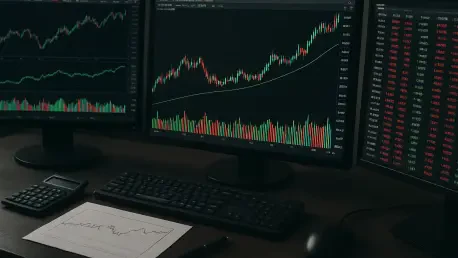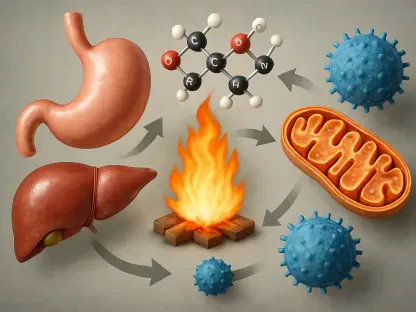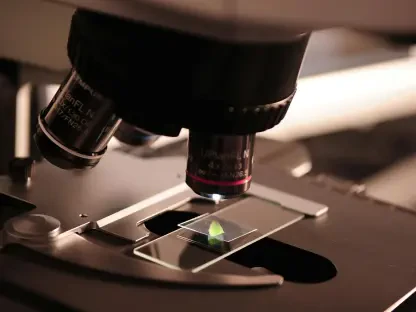Teva Pharmaceutical Industries Ltd. (NYSE:TEVA) has captured the attention of investors with a notable uptick in its stock price following the release of its second-quarter financial results, which showed a mix of challenges and successes. On Wednesday, the stock surged by 2.36% to $16.94, a movement that stands out against a backdrop of mixed financial outcomes. While the company fell short of revenue expectations, reporting $4.20 billion compared to the anticipated $4.29 billion, other elements of its performance appear to be igniting positive market sentiment. This intriguing contrast between missed targets and rising stock value suggests deeper strategic and operational strengths at play. The pharmaceutical giant’s ability to navigate industry challenges while capitalizing on emerging opportunities offers a compelling narrative for those tracking market trends. As the dust settles on these latest earnings, a closer examination of Teva’s financials, strategic pivots, and long-term vision reveals the underlying drivers of this upward trajectory.
Financial Performance Breakdown
Q2 Results: A Mixed Bag
Teva’s second-quarter financials present a complex picture, with revenue falling short of expectations at $4.20 billion against a forecast of $4.29 billion, reflecting challenges in certain segments. A significant contributor to this shortfall was the generics business, which saw a year-over-year revenue decline of 2% globally in local currency terms, excluding the impact of divested operations in Japan. The International Markets segment struggled, compounded by a 6% drop in U.S. generics sales, highlighting the intense competitive pressures and market saturation in this area. Additionally, legacy products like Copaxone, a treatment for multiple sclerosis, experienced a sharp 23% decline to $62 million, underscoring the diminishing returns from older offerings. Despite these headwinds, Teva’s ability to maintain flat revenue year-over-year in U.S. dollar terms suggests a level of resilience amid a tough generics landscape, setting the stage for other areas of growth to shine.
However, the revenue miss was not the full story, as Teva demonstrated significant strength in its innovative drug portfolio, which partially offset the weaker generics performance. Products like Austedo, a neurology drug, surged by 19% to $498 million, while Uzedy, a schizophrenia treatment, more than doubled to $54 million, and Ajovy, a migraine therapy, grew by 31% to $155 million. These figures point to a deliberate and successful shift toward high-margin therapies that are less vulnerable to the pricing wars plaguing generics. The contrast between declining traditional segments and robust growth in specialized treatments reflects an industry-wide trend where pharmaceutical companies are prioritizing innovation to drive revenue. This balance of challenges and successes in Teva’s financials provides a nuanced perspective on why the market remains optimistic despite the headline revenue disappointment.
Earnings Beat and Margin Improvement
On the earnings front, Teva outperformed expectations with adjusted earnings of 66 cents per share, surpassing the consensus estimate of 62 cents, signaling strong underlying profitability. This achievement was bolstered by an improved adjusted gross profit margin of 54.6%, up from 52.9% in the prior year, a clear indication of the financial benefits derived from focusing on higher-margin innovative products. The shift in product mix toward therapies like Austedo and Ajovy, which command better pricing power, has evidently contributed to this margin expansion. Management’s emphasis on operational efficiency also played a role, as cost controls and strategic divestitures helped maintain profitability despite top-line pressures. This earnings beat offers a critical counterpoint to the revenue shortfall, suggesting that Teva’s financial health remains robust even in a challenging market environment.
Moreover, the earnings success underscores the importance of Teva’s strategic focus on innovative drugs as the primary driver of financial stability and growth. The 26% revenue increase in this segment in local currency terms highlights how these products are not just supplementary but central to the company’s bottom line. Unlike generics, where competition erodes margins, innovative therapies provide a sustainable path to profitability, as they address unmet medical needs and face less immediate rivalry. This margin improvement also reflects Teva’s ability to adapt to evolving market dynamics, prioritizing areas with greater return potential. For investors, this performance metric likely serves as a reassuring signal that the company can deliver value even when revenue growth lags, contributing significantly to the positive stock movement observed on Wednesday.
Strategic Shifts and Growth Drivers
Pivot to Innovative Therapies and Biosimilars
Teva’s strategic pivot from a generics-heavy model to one centered on innovative medicines and biosimilars stands out as a cornerstone of its current market appeal. The company’s leadership has articulated a clear vision to build a $5 billion innovative medicines franchise by 2030, a goal that reflects confidence in the sustained growth of therapies like Austedo, Uzedy, and Ajovy. These products, targeting high-need areas such as neurology and psychiatry, have shown remarkable traction, with a collective revenue increase of 26% in local currency terms this quarter. This transition aligns with broader industry trends, where pharmaceutical firms are increasingly investing in specialized treatments to address complex conditions, thereby securing higher margins and longer market exclusivity. Teva’s focus on innovation not only diversifies its revenue streams but also positions it as a forward-thinking player in a competitive landscape.
In parallel, the biosimilars segment emerges as another promising growth avenue, with Teva planning to launch two new products in the second half of the year and aiming to double revenue in this category from current levels by 2027. Unlike generics, biosimilars offer a balance of affordability and innovation, targeting biologic drugs with expiring patents and providing cost-effective alternatives. The strong performance of existing biosimilars, coupled with new launches, signals Teva’s commitment to capturing a significant share of this expanding market. This strategic emphasis on biosimilars complements the innovative drug portfolio, creating a dual-engine growth model that mitigates the risks associated with generics’ declining profitability. For the market, this diversification into high-potential areas likely reinforces confidence in Teva’s ability to sustain long-term growth, fueling the recent stock price increase.
Long-Term Vision and Risk Management
Teva’s updated fiscal outlook for the year reveals a blend of caution and ambition, with adjusted earnings guidance narrowed to $2.50-$2.60 per share, slightly below the consensus of $2.53, while maintaining sales projections of $16.8 billion to $17.2 billion. This conservative stance accounts for potential external challenges, such as U.S. tariffs, which have been factored into non-GAAP projections, demonstrating prudent financial planning. At the same time, the company raised sales forecasts for key innovative drugs, including Austedo to $2 billion-$2.05 billion and Ajovy to $630 million-$640 million, reflecting optimism about their market potential. This balanced approach suggests that Teva is not only preparing for uncertainties but also banking on its high-growth segments to drive performance. Such forward-looking adjustments likely resonate with investors seeking stability alongside growth prospects.
Additionally, Teva’s limited reliance on supply chains in geopolitically sensitive regions like China and minimal exposure in India provides an extra layer of operational stability, as highlighted by management during recent discussions. This resilience against trade and supply disruptions contrasts with peers facing greater vulnerabilities, offering a competitive edge in an unpredictable global environment. Coupled with reaffirmed operating income and adjusted EBITDA guidance of $4.3 billion-$4.6 billion and $4.7 billion-$5 billion, respectively, Teva projects confidence in maintaining efficiency and profitability. This strategic risk management, combined with a robust pipeline of specialized therapies and biosimilars, paints a picture of a company in transition, steadily moving toward sustainable growth. The market’s positive response, as evidenced by the stock’s rise, appears to validate this long-term vision over short-term revenue fluctuations.









